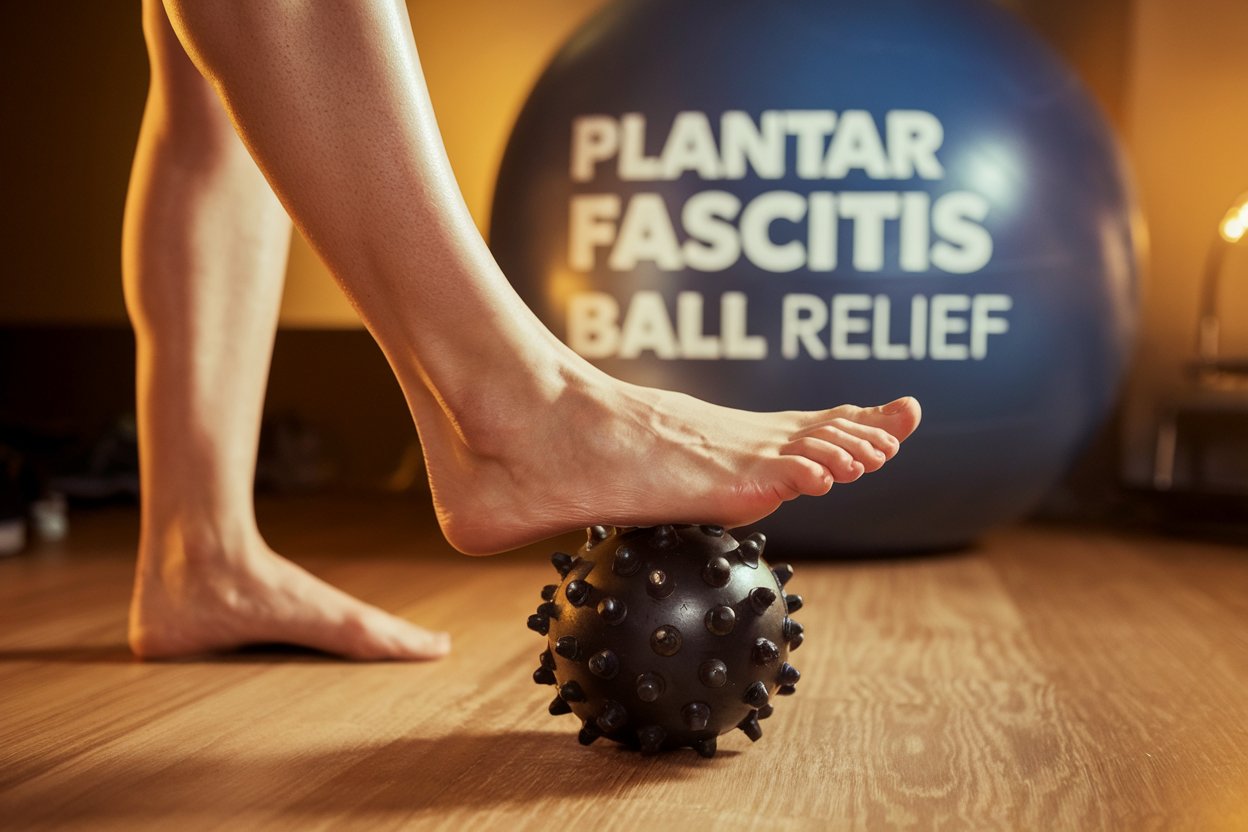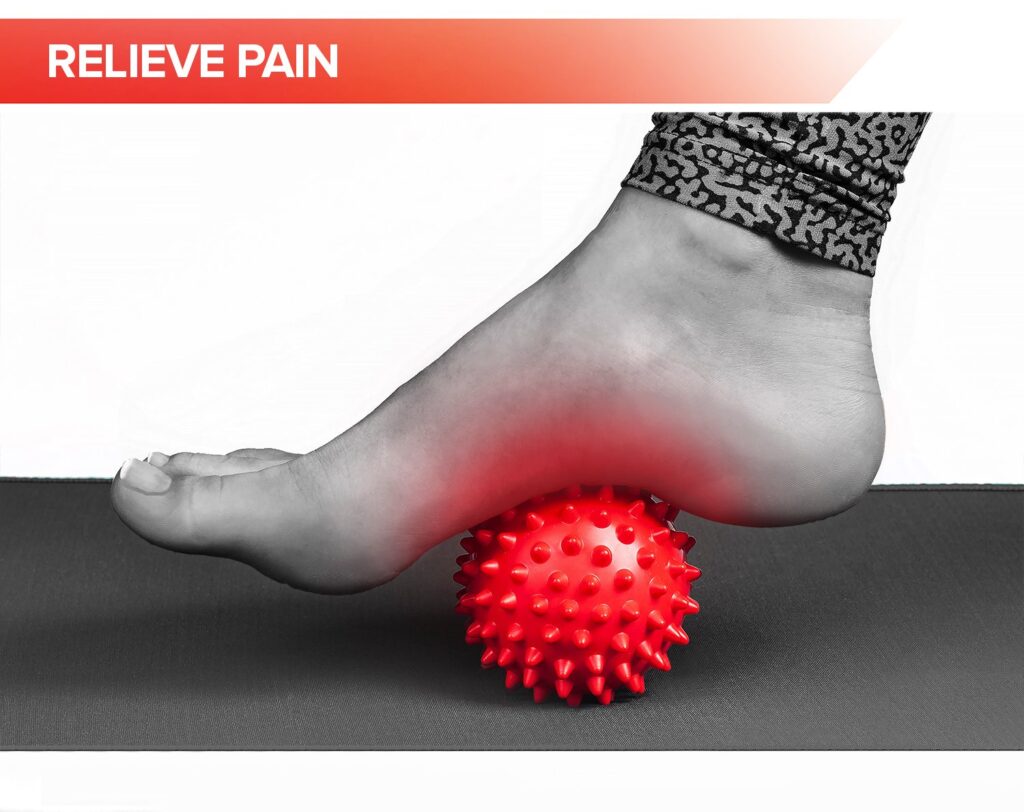Plantar Fasciitis Ball Relief – Soothe Your Feet

Imagine waking up to sharp pain in your heel with every step. For millions, this is the daily life with plantar fasciitis. It’s a common issue that leads to a lot of heel pain in the U.S. But, there’s hope for relief. Using a plantar fasciitis ball can help ease the pain. It lets you massage your feet yourself, helping them heal and feel better.
This article will cover different ways to treat plantar fasciitis. We’ll look at how foot massage balls work, important stretches for your calf and plantar fascia, and other tools for better foot care. Get ready to learn how to make your daily life more comfortable and mobile again.
Table of Contents
Understanding Plantar Fasciitis
Plantar fasciitis happens when the plantar fascia, a thick tissue band, gets inflamed. This usually comes from too much stress or overuse, causing tiny tears. Many people get it because of their age, being overweight, or doing high-impact sports.
Spotting the signs of plantar fasciitis early helps with treatment. You’ll feel sharp heel pain, especially when you first get up or after sitting a long time. Knowing these signs means you can start treatment right away.
Using treatments like soft tissue release through massage can help heal foot pain. Studies show that doing it yourself can be just as good as going to a professional. Massaging the plantar fascia and muscles like the calves and hamstrings helps a lot. A full treatment plan might include stretching and other therapies to fix the real cause of the pain.
Wearing the right shoes and making lifestyle changes is key to managing plantar fasciitis. Shoes with good arch support ease the strain on the plantar fascia. Keeping a healthy weight also lowers stress on your feet. By understanding plantar fasciitis, you can take steps to get better and prevent it from happening again.
Common Symptoms of Plantar Fasciitis
Plantar fasciitis is a common condition that brings sharp heel pain symptoms. This pain usually hits when you first step out of bed or after sitting still for a while. It feels like a stabbing pain, mainly near the heel.
As it gets worse, you might feel constant pain in your foot’s arch, especially after being active or standing a lot. Things like being more active, your foot shape, and the shoes you wear can make the fascia inflamed.
Spotting plantar fasciitis symptoms early is key to managing it well. Rest and stretching exercises that focus on the plantar fascia and Achilles tendon can help. Remember, if you don’t treat it, plantar fasciitis can turn into chronic heel pain. Check out this detailed guide on keeping your health in check here.
The table below outlines some common symptoms and their descriptions:
| Symptom | Description |
|---|---|
| Sharp Pain | Intense heel pain, especially noticeable in the morning or after inactivity. |
| Pain in Arch | Discomfort and aching in the arch of the foot during movement. |
| Worsening Discomfort | Pain increases after prolonged standing or physical activity. |
| Morning Stiffness | Stiffness in the feet upon waking that typically eases after a few steps. |
Causes of Heel Pain and Plantar Fasciitis
Understanding the causes of plantar fasciitis is key to managing and preventing heel pain. This condition is very common, affecting many people. It leads to about 1 million visits to the doctor each year, showing how important it is to know what causes it.
Several factors can lead to plantar fasciitis:
- Overuse from physical activities: Running or high-impact sports can strain the plantar fascia.
- Excessive body weight: Being overweight or obese increases the risk.
- Improper footwear: Wearing shoes that don’t support your feet can make heel pain worse.
- Inadequate foot mechanics: Flat feet, high arches, or odd walking patterns can cause the condition.
- Age: People between 40 and 60, especially active workers, are most likely to get it.
- Gender: Women are more likely to have plantar fasciitis than men.
About 10% of people get plantar fasciitis, and it often affects both feet. Runners face a 22% risk, and 83% of cases are in people aged 25 to 65 who are active. Knowing the heel pain causes is crucial for athletes and those who stand a lot.
| Factor | Influence on Plantar Fasciitis |
|---|---|
| Body Weight | Being overweight puts more pressure on the plantar fascia, causing pain. |
| Age | People aged 40-60 are more at risk due to changes in the fascia. |
| Foot Structure | Flat feet or high arches strain the plantar fascia. |
| Activity Level | Being active, especially running, makes you more likely to get it. |
| Footwear Quality | Shoes with poor arch support increase the risk of heel pain. |
Knowing these factors helps people change their habits and choose better shoes. Making lifestyle changes like managing weight and wearing supportive shoes can help prevent pain and inflammation.
Benefits of Using a Plantar Fasciitis Ball

The plantar fasciitis ball helps people with heel pain. Using it in your foot massage routine can boost your foot health.
Stimulates Blood Flow and Circulation
Rolling on the plantar fasciitis ball improves blood flow in your foot. This helps healing by bringing oxygen and nutrients to sore spots. Studies show that combining foot massage with stretching helps reduce pain quickly.
Relaxes Tight Muscles and Ligaments
This ball is great for easing tight foot muscles and ligaments. By rolling your foot on it, you can ease tension. This leads to better flexibility and comfort. Massaging with the right pressure can also help break up tissue adhesions, improving mobility.
Reduces Inflammation and Pain
The ball also helps reduce inflammation and pain. Cold therapy can make the massage even better. For example, using a frozen golf ball combines cold with massage to ease sore heels and reduce swelling. Regular use can help manage plantar fasciitis pain.
How to Use a Plantar Fasciitis Ball

Learning to use a plantar fasciitis ball can make your feet feel better. This tool helps ease tension and reduce pain in the plantar fascia. By doing simple self-massage techniques, you can improve your foot care and feel relief right away.
Simple Techniques for Self-Massage
Start by sitting comfortably and rolling your foot over the ball. Begin with gentle pressure on sore spots for about 30 seconds. Aim to do this 2-3 times a day.
Try using different balls like a tennis ball for a soft touch or a lacrosse ball for more pressure. Your choice depends on how sensitive your feet are. Keep a relaxed posture to get the most out of your massage.
Best Time to Use the Ball for Maximum Relief

When you use the ball matters a lot for getting relief. It’s best after exercise or when you’ve been standing a lot. This helps with muscle soreness and tension.
Rolling your feet throughout the day helps loosen tight fascia. This is important because plantar fasciitis comes from the plantar fascia getting thick and inflamed. Adding stretching exercises with the ball can make it even more effective.
| Technique | Duration | Frequency |
|---|---|---|
| Rolling Massage | 30 seconds | 2-3 times daily |
| Stretching with Ball | 5 seconds hold | 8-10 repetitions |
| Standing Massage | As needed | When sitting massage is ineffective |
For more comfort, keep a healthy weight and wear supportive shoes. For tips on staying healthy, check out resources on testicular health. They show how important it is to take care of your body.
Additional Tools for Foot Massage
When dealing with foot pain from plantar fasciitis, using different foot massage tools can really help. Instead of just a plantar fasciitis ball, you can try foot rollers, tennis balls, or even frozen water bottles. These can be very effective substitutes.
Here are some popular options:
- Arch Massager: Priced at $79.00, this tool helps to break up painful scar tissue and reduce tension in the feet.
- Manual Foot Massager: Affordable starter option, costing around $8, offering basic relief.
- Electric Foot Massager with Heat: Available for $120, this provides both warmth and massage for enhanced relaxation.
- Electric Percussion Massage Device: With prices ranging from $149 to $229, these devices feature multiple pressure settings.
A good rule of thumb is to use massage tools for about two minutes. This short session can help relieve pain as effectively as physical therapy. It’s a quick way to find relief.
Adding these tools to your routine lets you take charge of your healing. With prices from $8 to $350, there’s something for every budget. Whether you like manual or electric massagers, finding the right one can make a big difference in your comfort and recovery.
Exercises for Plantar Fasciitis Relief
Effective exercises are key in managing and easing plantar fasciitis pain, also known as heel spur pain. Adding specific heel pain exercises to your daily routine can lessen pain and boost foot health.
Calf Stretching Techniques
Calf stretches help ease tension on the plantar fascia. Here’s a simple way to do it:
- Stand facing a wall with one foot in front of the other.
- Keep your back leg straight and your heel on the ground.
- Lean into the wall, bending your front knee until you feel a stretch in the calf muscle of your back leg.
- Hold for 30 seconds and repeat 3-5 times.
Plantar Fascia Stretching Exercises
These exercises target inflammation and improve fascia flexibility. Try these movements:
- Toe curls with a towel: Sit down, place a towel under your toes, and pull the towel toward you while keeping your heel on the ground. Repeat for 3-5 minutes.
- Tennis ball roll: Sit in a chair and roll a tennis ball under your foot for 2-5 minutes daily.
- Plantar fascia stretch on a step: Stand on a step with your heels hanging off the edge, then slowly lower your heels down and hold for 30 seconds.
Ice Massage Techniques
Icing the affected areas reduces pain and swelling. Here’s a simple method:
- Freeze a water bottle, then roll it under your foot for 10-15 minutes.
- This goes well with pre-exercise ice treatment to manage inflammation.
| Exercise | Description | Frequency |
|---|---|---|
| Cow Stretch | Stretch calf muscles by leaning against a wall. | 3-5 reps, hold for 30 seconds |
| Towel Curls | Use a towel to curl your toes and stretch the fascia. | 3-5 minutes |
| Tennis Ball Roll | Roll a tennis ball underfoot for muscle relaxation. | 2-5 minutes daily |
| Plantar Fascia Stretch on a Step | Stretch your arches by lowering heels off a step. | Hold for 30 seconds, repeat 4-6 times |
Adding these exercises for plantar fasciitis to your daily routine can help with long-term relief. Always talk to a healthcare provider before starting new exercises, especially if they cause more pain.
Integrating Foot Rollers into Your Routine
Foot rollers are great for managing plantar fasciitis. They add a new layer to your healing plan.
Adding foot rollers to your daily routine boosts your self-care. Roll your foot over the roller after or with a plantar fasciitis ball. This helps with blood flow and eases tension in the fascia and arch.
Foot rollers target key pressure points in your foot. Here are some benefits:
- Improved circulation: Regular use boosts blood flow, aiding recovery and reducing pain.
- Increased flexibility: Regular rolling can enhance overall foot flexibility, contributing to better mobility.
- Convenience: Foot rollers are easy to use at home or when on the go, making them a portable solution for foot pain.
Using foot rollers with stretching and icing can boost their effects. This creates a full plan for foot health. For more on health tips, see this resource.
| Benefits of Foot Rollers | Description |
|---|---|
| Boosts Circulation | Enhances blood flow to the injured fascia, aiding recovery. |
| Alleviates Pain | Helps relieve discomfort in foot and heel areas. |
| Enhances Flexibility | Improves the range of motion and foot function over time. |
| Portable Therapy | Easy to use anywhere, allowing for quick relief during breaks. |
Regular use of foot rollers can greatly improve foot health. Sticking with it is key for lasting benefits and managing plantar fasciitis symptoms.
When to Seek Professional Help
Knowing when to get help for plantar fasciitis can really help your recovery. If your symptoms don’t get better with home care or get worse, you should see a doctor. You should go to a doctor if you have:
- Severe, persistent pain
- Swelling that does not subside
- Numbness in the foot
A podiatrist can give you a treatment plan that fits your needs. They can offer many options, such as:
- Physical therapy to help heal and strengthen your feet
- Prescription orthotics for extra support
- Surgery if other treatments don’t work, which is rare
- Extracorporeal shock wave therapy for long-term cases
Being aware of your condition is key to finding relief. Most people get better in a few months with simple treatments like stretching and changing how they move. If these steps don’t work, getting professional help for plantar fasciitis can lead to better solutions for you.
Preventive Measures for Plantar Fasciitis
Preventing plantar fasciitis means taking good care of your feet. Wearing the right shoes is key. Sneakers should be replaced every six to nine months to keep them supportive. This helps avoid heel pain.
Runners might want two pairs of shoes to switch between every other day, as Dr. Long suggests. This helps spread out the wear and stress on your feet.
Stretching and strengthening exercises are also important. They help prevent heel pain. Stretching the Achilles tendon and plantar fascia makes your feet more flexible and less tight.
Physical therapists can create exercise plans just for you. This is great for athletes or people who stand a lot. It ensures you get the right care you need.
Rest is also crucial for preventing plantar fasciitis. Taking a day off from hard activities each week helps your feet heal. If you’re in pain, try low-impact exercises like cycling or swimming. This keeps you fit while your feet recover.
Looking after your feet every day helps prevent problems. Doing exercises at home, like heel raises and toe towel scrunches, makes your muscles stronger. Also, taking breaks from standing or walking can ease foot tension.
If you’re still in pain after 4 to 6 weeks, see a podiatrist or foot specialist. They can check what’s going on and recommend more treatment that fits your needs.
Choosing the Right Products for Foot Care
Choosing the right foot care products is key to managing plantar fasciitis and feeling comfortable. Quality tools and supportive items can greatly help with pain relief and foot health. Let’s look at foot massage balls and the role of orthotic support to find the best products for you.
Foot Massage Balls and Their Features
Foot massage balls help by easing tension in the plantar fascia. When picking a foot massage ball, think about these features:
- Grip: Pick a ball with a textured surface for better grip.
- Durability: Choose materials that last through regular use.
- Size: Select a size that fits your feet well.
These products can lessen pain and help you relax after a long day. Whether you choose a simple massage ball or a more advanced one, they’re great for your foot care routine.
Importance of Orthotic Support
Orthotics are crucial for easing plantar fasciitis pain. They offer arch support, easing strain on the plantar fascia. Here are some top picks:
- Vasyli+McPoil Tissue Stress Relief Orthotics: Great for active people, these orthotics reduce discomfort.
- Vasyli+Hoke Supination Control Orthotic: Perfect for daily wear, it helps with stability and alignment.
- Walk-Hero Insoles: Excellent for easing knee, shin, and ankle pain during daily tasks.
It’s important to pick the right orthotics for all-day pain relief, especially if you’re on your feet a lot. Adding these products to your routine can boost your comfort and mobility.
Real-Life Success Stories of Plantar Fasciitis Relief
Many people have beaten plantar fasciitis, showing how important determination and self-care are. Sarah suffered from heel pain for almost nine months before trying surgery. After the surgery, she got much better. She felt little pain after surgery and got about 90-95% better in a few months.
Another person started with a lot of pain, scoring an 8 on a 1 to 10 scale. After the Tenex procedure, their pain went down by 60-70% in five weeks. They could walk easily again. They say regular stretching and physical therapy helped a lot, proving consistent care is key.
These stories show that getting better from plantar fasciitis is possible. They highlight the need for special treatments and give hope to those recovering. Using a plantar fasciitis ball and doing specific exercises can make a big difference, leading to a life without pain.
FAQ
What is a plantar fasciitis ball and how does it help with heel pain relief?
What are the common symptoms of plantar fasciitis?
Can exercises for plantar fasciitis really help in recovery?
How often should I use a plantar fasciitis ball?
What other tools can I use for foot massage therapy?
When should I consult a healthcare professional about my plantar fasciitis?
What preventive measures can I take to avoid developing plantar fasciitis?
How do I choose the right products for foot care?
Are there real-life success stories of individuals finding relief from plantar fasciitis?







